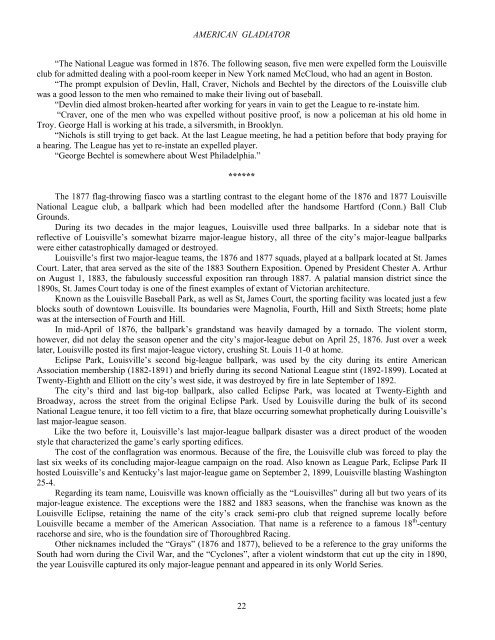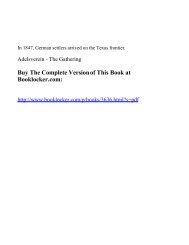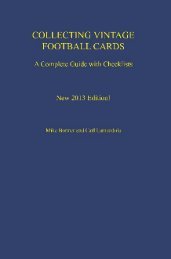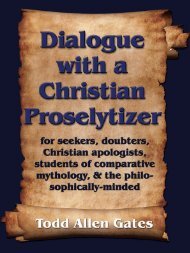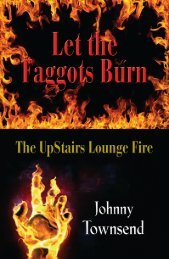AMERICAN GLADIATOR: The Life And Times Of ... - The Book Locker
AMERICAN GLADIATOR: The Life And Times Of ... - The Book Locker
AMERICAN GLADIATOR: The Life And Times Of ... - The Book Locker
Create successful ePaper yourself
Turn your PDF publications into a flip-book with our unique Google optimized e-Paper software.
<strong>AMERICAN</strong> <strong>GLADIATOR</strong><br />
“<strong>The</strong> National League was formed in 1876. <strong>The</strong> following season, five men were expelled form the Louisville<br />
club for admitted dealing with a pool-room keeper in New York named McCloud, who had an agent in Boston.<br />
“<strong>The</strong> prompt expulsion of Devlin, Hall, Craver, Nichols and Bechtel by the directors of the Louisville club<br />
was a good lesson to the men who remained to make their living out of baseball.<br />
“Devlin died almost broken-hearted after working for years in vain to get the League to re-instate him.<br />
“Craver, one of the men who was expelled without positive proof, is now a policeman at his old home in<br />
Troy. George Hall is working at his trade, a silversmith, in Brooklyn.<br />
“Nichols is still trying to get back. At the last League meeting, he had a petition before that body praying for<br />
a hearing. <strong>The</strong> League has yet to re-instate an expelled player.<br />
“George Bechtel is somewhere about West Philadelphia.”<br />
******<br />
<strong>The</strong> 1877 flag-throwing fiasco was a startling contrast to the elegant home of the 1876 and 1877 Louisville<br />
National League club, a ballpark which had been modelled after the handsome Hartford (Conn.) Ball Club<br />
Grounds.<br />
During its two decades in the major leagues, Louisville used three ballparks. In a sidebar note that is<br />
reflective of Louisville’s somewhat bizarre major-league history, all three of the city’s major-league ballparks<br />
were either catastrophically damaged or destroyed.<br />
Louisville’s first two major-league teams, the 1876 and 1877 squads, played at a ballpark located at St. James<br />
Court. Later, that area served as the site of the 1883 Southern Exposition. Opened by President Chester A. Arthur<br />
on August 1, 1883, the fabulously successful exposition ran through 1887. A palatial mansion district since the<br />
1890s, St. James Court today is one of the finest examples of extant of Victorian architecture.<br />
Known as the Louisville Baseball Park, as well as St, James Court, the sporting facility was located just a few<br />
blocks south of downtown Louisville. Its boundaries were Magnolia, Fourth, Hill and Sixth Streets; home plate<br />
was at the intersection of Fourth and Hill.<br />
In mid-April of 1876, the ballpark’s grandstand was heavily damaged by a tornado. <strong>The</strong> violent storm,<br />
however, did not delay the season opener and the city’s major-league debut on April 25, 1876. Just over a week<br />
later, Louisville posted its first major-league victory, crushing St. Louis 11-0 at home.<br />
Eclipse Park, Louisville’s second big-league ballpark, was used by the city during its entire American<br />
Association membership (1882-1891) and briefly during its second National League stint (1892-1899). Located at<br />
Twenty-Eighth and Elliott on the city’s west side, it was destroyed by fire in late September of 1892.<br />
<strong>The</strong> city’s third and last big-top ballpark, also called Eclipse Park, was located at Twenty-Eighth and<br />
Broadway, across the street from the original Eclipse Park. Used by Louisville during the bulk of its second<br />
National League tenure, it too fell victim to a fire, that blaze occurring somewhat prophetically during Louisville’s<br />
last major-league season.<br />
Like the two before it, Louisville’s last major-league ballpark disaster was a direct product of the wooden<br />
style that characterized the game’s early sporting edifices.<br />
<strong>The</strong> cost of the conflagration was enormous. Because of the fire, the Louisville club was forced to play the<br />
last six weeks of its concluding major-league campaign on the road. Also known as League Park, Eclipse Park II<br />
hosted Louisville’s and Kentucky’s last major-league game on September 2, 1899, Louisville blasting Washington<br />
25-4.<br />
Regarding its team name, Louisville was known officially as the “Louisvilles” during all but two years of its<br />
major-league existence. <strong>The</strong> exceptions were the 1882 and 1883 seasons, when the franchise was known as the<br />
Louisville Eclipse, retaining the name of the city’s crack semi-pro club that reigned supreme locally before<br />
Louisville became a member of the American Association. That name is a reference to a famous 18 th -century<br />
racehorse and sire, who is the foundation sire of Thoroughbred Racing.<br />
Other nicknames included the “Grays” (1876 and 1877), believed to be a reference to the gray uniforms the<br />
South had worn during the Civil War, and the “Cyclones”, after a violent windstorm that cut up the city in 1890,<br />
the year Louisville captured its only major-league pennant and appeared in its only World Series.<br />
22


